PREVIEW OF MESSENGER MERCURY ORBIT INSERTION
March 15, 2011, at 1 p.m. EDT
Introduction
After more than a dozen laps through the inner solar system, NASA's MErcury Surface, Space ENvironment, GEochemistry, and Ranging (MESSENGER) spacecraft will move into orbit around Mercury on March 17. The durable, APL-built spacecraft – carrying seven science instruments and fortified against the blistering environs near the Sun – will be the first to orbit the innermost planet. While orbiting Mercury, MESSENGER’s instruments will perform the first complete reconnaissance of the cratered planet’s geochemistry, geophysics, geologic history, atmosphere, magnetosphere, and plasma environment.
MESSENGER Panelist Biographies
Presenter #1
Andrew B. Calloway, MESSENGER Mission Operations Manager
The Johns Hopkins University Applied Physics Laboratory
 |
Andrew Calloway has more than 17 years experience in space mission operations and ground system development efforts. He began his career supporting multiple commercial and international geosynchronous communications satellite launches and operations. He then spent six years supporting the Tropical Rainfall Measuring Mission, a low-Earth-orbiting Earth resources satellite, at NASA Goddard Space Flight Center, where he spent the last four years as the technical operations lead. He has been a member of the MESSENGER operations team since he joined The Johns Hopkins University Applied Physics Laboratory (APL) in 2002.
Contact Information: 240.228.8221
E-mail: andy.calloway@jhuapl.edu |
Presenter #2
Carl S. Engelbrecht, MESSENGER Propulsion Subsystem Lead
The Johns Hopkins University Applied Physics Laboratory
 |
Carl Engelbrecht has more than 25 years of experience at the Jet Propulsion Laboratory, Aerojet (Redmond), Daimler-Benz Aerospace AG (Germany), and APL in the analysis, design, procurement, and integration and test of a wide range of types of electric, and chemical space propulsion components and systems. His experience includes systems and subsystem engineering, line and technical management, and leadership of internal and subcontractor teams. His direct work experience spans a wide range from launch vehicles to deep space probes. He has served as spacecraft system engineer on the Liquid Plume Experiment (LPX) program, and supported and led propulsion system development on Galileo (Jupiter), Magellan (Venus), Cassini (Saturn), MESSENGER (Mercury), New Horizons (Pluto), STEREO, SMART-1, Coriolis, and Deep Space 1, and launch vehicle attitude control systems for the Ariane V and Athena launch vehicles.
Contact Information: 240.228.0397
E-mail: carl.engelbrecht@jhuapl.edu |
Presenter #3
Sean Solomon, MESSENGER Principal Investigator
Carnegie Institution of Washington, Washington
 |
As Principal Investigator for the MErcury Surface, Space ENvironment, GEochemistry, and Ranging (MESSENGER) mission, Sean Solomon heads a multi-institutional consortium of scientists and engineers who operate the small, efficient spacecraft, which launched in 2004 and will reach its target orbit in 2011.
Prior to MESSENGER, the only craft sent to Mercury was Mariner 10 in the 1970s, and it imaged less than half of the planet. With a suite of seven miniaturized instruments, MESSENGER will address questions that are key to understanding terrestrial planet evolution. Solomon's particular interests are to learn more about Mercury's bulk composition and what that tells us about planet formation in general; to investigate Mercury's volcanic, tectonic, and internal evolution; and to understand how the planet's magnetic field originated and determine the characteristics of Mercury's liquid outer core. Mariner 10 discovered that Mercury has a weak magnetic field, which may arise from an Earth-like electromagnetic dynamo in the planet's outer core. MESSENGER will investigate this question as well as the nature of the planet's thin atmosphere and the composition of the permanently shadowed polar deposits.
Solomon has also been a team member on a variety of other projects, including the Magellan mission to Venus, the Mars Orbiter Laser Altimeter (MOLA) investigation on the Mars Global Surveyor spacecraft, and the Plume-Lithosphere Undersea Melt Experiment (PLUME) on Earth. The Magellan mission produced global radar image and altimetric maps of the surface of Venus. Data from MOLA have been used to construct precise topographical maps to understand Martian geology, geophysics, and atmospheric circulation. PLUME is a combined land and ocean-bottom seismic experiment to image the mantle beneath the Hawaiian hotspot. Solomon led the land section of this project.
Solomon balances his position as director of Carnegie Institution of Washington's Department of Terrestrial Magnetism with research in planetary geology and geophysics, seismology, marine geophysics, and geodynamics. Prior to accepting his current position, he was a professor of geophysics at the Massachusetts Institute of Technology for more than 20 years. He is a member of the National Academy of Sciences, a fellow of the American Academy of Arts and Sciences, and a former president of the American Geophysical Union.
Contact Information: 202.478.8850
E-mail: scs@dtm.ciw.edu |
Resources
MESSENGER Primed for Mercury Orbit - March 15, 2011
Multimedia
Presenter #1 |
Andrew B. Calloway, MESSENGER Mission Operations Manager
The Johns Hopkins University Applied Physics Laboratory
Video 1.1
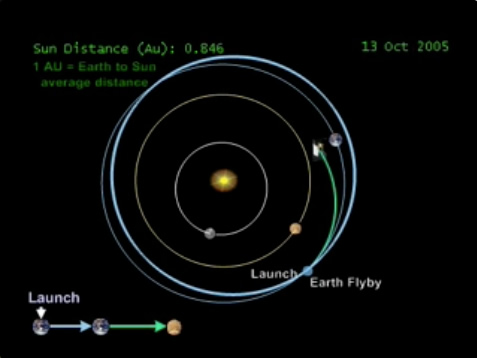
This animation follows MESSENGER’s journey from launch on August 3, 2004, through flybys of Earth, Venus, and Mercury, to arrival at Mercury for orbit insertion on March 18, 2011 (UTC). The relative motions of Earth, Venus, Mercury, and the MESSENGER spacecraft, which completed nearly 16 orbits around the Sun, are shown in the plane of Earth’s orbit. The timeline at the bottom tracks the spacecraft’s progress from launch to Mercury orbit insertion.
Click on image to watch video.
|
|
Image 1.1
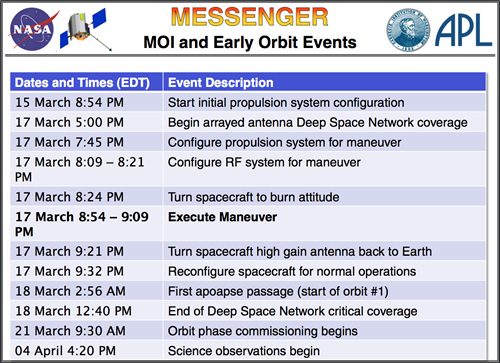
High-level summary of the timeline leading up to and following Mercury orbit insertion. Additional details can be found on the MESSENGER website.
Click on image to enlarge.
|
|
Presenter #2 |
Carl S. Engelbrecht, MESSENGER Propulsion Subsystem Lead
The Johns Hopkins University Applied Physics Laboratory
Image 2.1
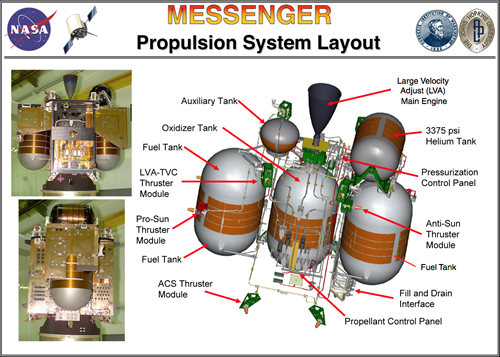
MESSENGER's propulsion system, built by Aerojet in Sacramento, California, is innovative in its degree of integration with the compact spacecraft, a design that allowed a high fraction (~55%) of the spacecraft mass at launch to be propellant. That propellant budget has been critical to the execution of MESSENGER's several major maneuvers, including orbit insertion.
Click on image to enlarge.
|
|
Image 2.2
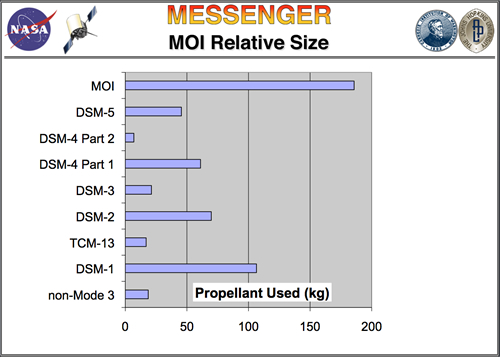
The MOI maneuver is the largest planned for the MESSENGER propulsion system. This chart compares MOI to the other major deep-space maneuvers (DSMs) and smaller trajectory-correction maneuvers (TCMs) of the mission.
Click on image to enlarge.
|
|
Presenter #3 |
Sean Solomon, MESSENGER Principal Investigator
Carnegie Institution of Washington, Washington
Image 3.1
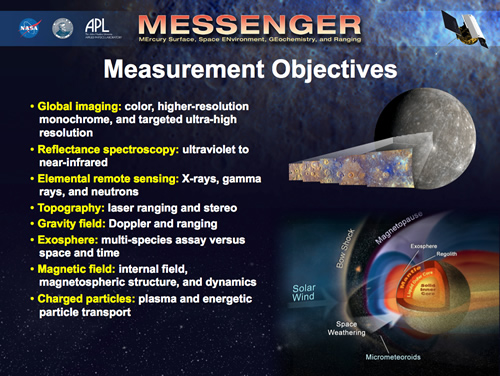
As the first spacecraft to orbit Mercury, MESSENGER has a comprehensive list of measurements planned for its one year of orbital observations.
Click on image to enlarge.
|
|
Image 3.2
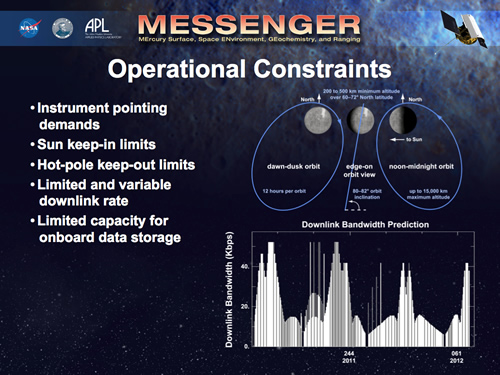
There are a variety of scientific and spacecraft operational constraints that must be met if the scientific objectives are to be achieved and the spacecraft is to remain healthy. The MESSENGER team solved this optimization problem with an automated scientific planning software package called SciBox, with which a year-long observational campaign that meets all mission science objectives and satisfies all operational constraints was designed and tested.
Click on image to enlarge.
|
|
Video 3.1
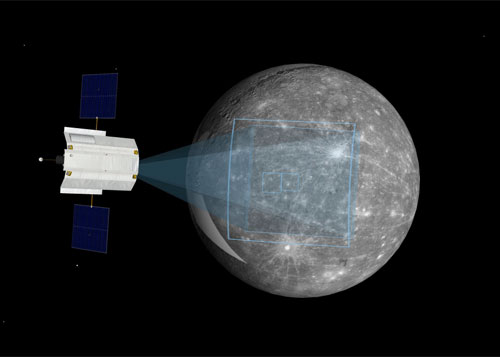
This animation depicts some of the science operations that will be completed during a typical single
orbit in the first week of scientific mapping. At different parts of the orbit, different instruments control spacecraft pointing. Blue frames on the planet denote imaging with either MESSENGER's wide-angle or narrow-angle camera. The green line denotes an observation of Mercury's exosphere with MESSENGER's Ultraviolet and Visible Spectrometer. The red circles denote topographic profiling with the Mercury Laser Altimeter. The magenta scans denote remote sensing of surface elemental composition by MESSENGER's X-Ray Spectrometer and Gamma-Ray and Neutron Spectrometer. Time during the animation is unevenly scaled to time in orbit to permit several of the principal scientific operations to be displayed clearly.
View Small QuickTime (640x360,38M)
View Medium QuickTime (1280x720,50M)
View Large QuickTime (1280x720,111M)
|
|
Contact Information
Paulette Campbell
The Johns Hopkins University Applied Physics Laboratory
Laurel, Maryland
Phone: 240.228.6792
Dwayne Brown
NASA Headquarters
Washington, DC
Phone: 202.358.1726/3895
Tina McDowell
Carnegie Institution of Washington
Washington, DC
Phone: 202.939.1120
Event Information
The NASA MESSENGER Science Update will take place on Tuesday, March 15, 2011, at 1 p.m. EDT. Reporters may ask questions from participating NASA locations. The briefing also will be streamed live on NASA's Web site at: http://www.nasa.gov.









